2015 MERCEDES-BENZ SLS AMG GT COUPE child restraint
[x] Cancel search: child restraintPage 7 of 290
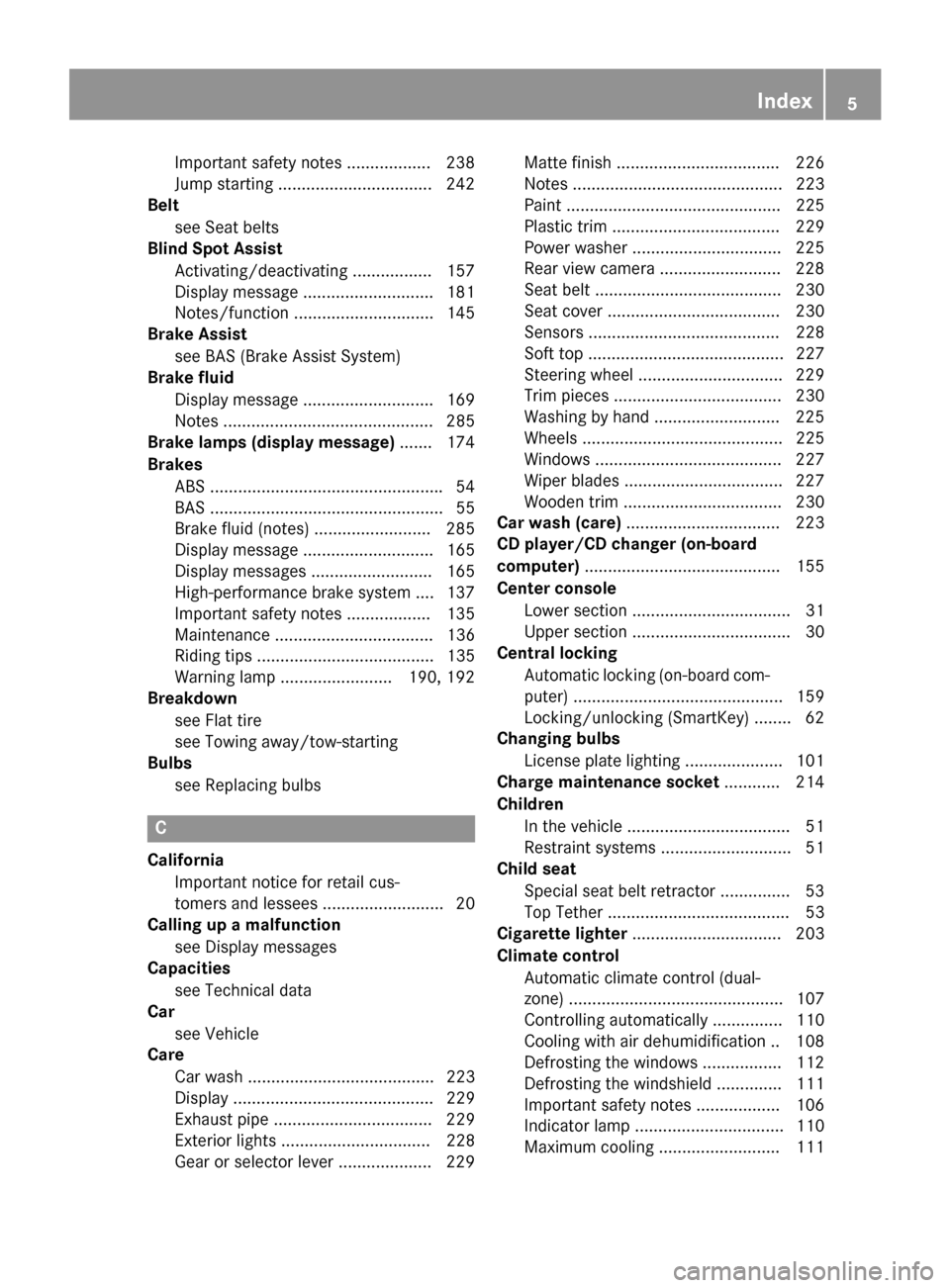
Important safety notes .................. 238
Jump starting .................................2
42
Belt
see Seat belts
Blin dSpot Assist
Activating/deactivating ................. 157
Display message ............................ 181
Notes/function .............................. 145
Brake Assist
see BAS (Brake Assist System)
Brake fluid
Display message ............................ 169
Notes ............................................. 285
Brake lamps (display message) ....... 174
Brakes ABS ................................................. .54
BAS .................................................. 55
Brake fluid (notes) ......................... 285
Displa ymessag e............................ 165
Displa ymessages .......................... 165
High-performance brake system .... 137
Important safety notes .................. 135
Maintenance .................................. 136
Riding tip s...................................... 135
Warning lamp ........................ 190 ,192
Breakdown
see Fla ttire
see Towing away/tow-starting
Bulbs
see Replacing bulbs C
California Important notice for retail cus-
tomers and lessees .......................... 20
Calling up amalfunction
see Displa ymessages
Capacities
see Technica ldata
Car
see Vehicle
Care
Carw ash. ....................................... 223
Displa y........................................... 229
Exhaus tpipe. ................................. 229
Exterior lights ................................ 228
Gear or selector lever .................... 229 Matte finish ................................... 226
Note
s............................................. 223
Paint .............................................. 225
Plastic trim .................................... 229
Power washe r................................ 225
Rear vie wcamera .......................... 228
Sea tbelt. ....................................... 230
Sea tcove r..................................... 230
Sensors ......................................... 228
Soft top .......................................... 227
Steering whee l............................... 229
Tri mp iece s.................................... 230
Washing by hand ........................... 225
Wheel s........................................... 225
Window s........................................ 227
Wipe rblade s.................................. 227
Woode ntrim .................................. 230
Car was h(care) ................................. 223
CD player/CD changer (on-board
computer) .......................................... 155
Cente rconsole
Lower section .................................. 31
Upper section .................................. 30
Central locking
Automati cloc king (on-board com-
puter) ............................................. 159
Locking/unlocking (SmartKey )........ 62
Changin gbulbs
License plate lighting ..................... 101
Charge maintenanc esocket ............ 214
Children In the vehicl e................................... 51
Restraint systems ............................ 51
Child seat
Specia lsea tb eltr etractor ............... 53
Top Tether ....................................... 53
Cigarette lighter ................................ 203
Climate control Automati cclimate control (dual-
zone) .............................................. 107
Controlling automaticall y............... 110
Cooling with ai rdehumidifica tion .. 108
Defrosting the window s................. 112
Defrosting the windshield .............. 111
Important safety notes .................. 106
Indicato rlam p................................ 110
Maximu mcooling .......................... 111 Index
5
Page 14 of 290
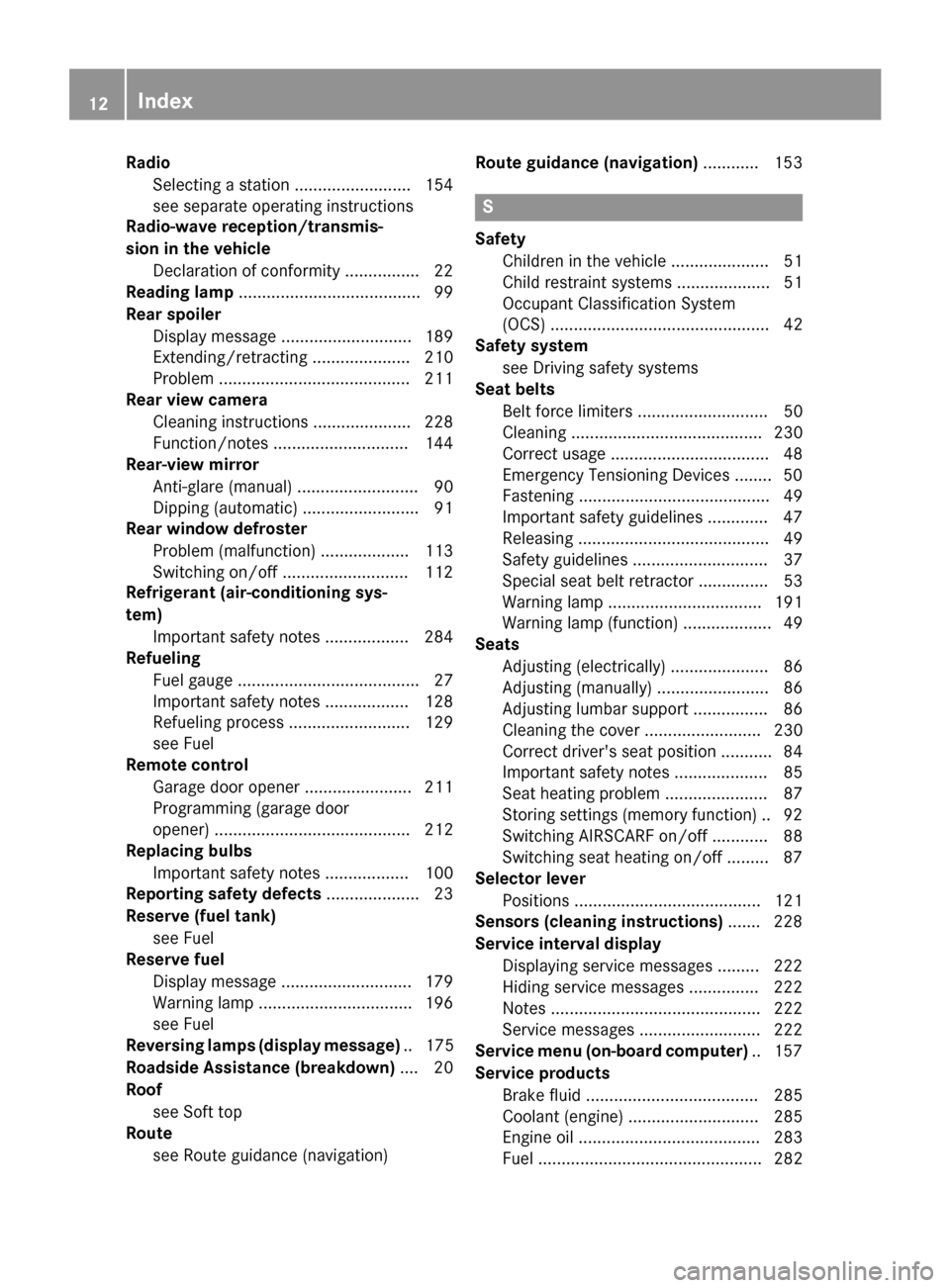
Radio
Selecting astation ......................... 154
see separate operating instructions
Radio-wav ereception/transmis-
sion in the vehicle Declaration of conformity ................ 22
Reading lamp ....................................... 99
Rear spoiler Displa ymessag e............................ 189
Extending/retracting ..................... 210
Problem ......................................... 211
Rear vie wcamera
Cleaning instructions ..................... 228
Function/note s............................. 144
Rear-vie wmirror
Anti-glare (manual) .......................... 90
Dipping (automatic) ......................... 91
Rear windo wdefroster
Problem (malfunction) ................... 113
Switching on/of f........................... 112
Refrigerant (air-conditioning sys-
tem) Important safety notes .................. 284
Refueling
Fuelgauge ....................................... 27
Important safety notes .................. 128
Refueling process .......................... 129
see Fuel
Remote control
Garag edooro pener ....................... 211
Programming (garage door
opener) .......................................... 212
Replacing bulbs
Important safety notes .................. 100
Reporting safety defects .................... 23
Reserve (fuel tank) see Fuel
Reserve fuel
Displa ymessage ............................ 179
Warning lamp ................................. 196
see Fuel
Reversin glamps (display message) .. 175
Roadside Assistance (breakdown) .... 20
Roof see Soft top
Route
see Route guidance (navigation) Route guidanc
e(navigation) ............ 153 S
Safety Childre ninthe vehicl e..................... 51
Chil drestraint systems .................... 51
Occupant Classification System
(OCS) ............................................... 42
Safety system
see Driving safety systems
Seat belts
Beltforce limiters ............................ 50
Cleaning ......................................... 230
Correct usag e.................................. 48
Emergency Tensioning Devices ........ 50
Fastening ......................................... 49
Important safety guideline s............. 47
Releasing ......................................... 49
Safety guideline s............................. 37
Specia lsea tb eltr etractor ............... 53
Warning lamp ................................. 191
Warning lamp (function) ................... 49
Seats
Adjusting (electrically) ..................... 86
Adjusting (manually) ........................ 86
Adjusting lumba rsuppo rt ................ 86
Cleaning the cove r......................... 230
Correct driver' sseatp osition ........... 84
Important safety notes .................... 85
Sea theating problem ...................... 87
Storing settings (memory function) .. 92 Switching AIRSCAR Fon/of f............ 88
Switching sea theating on/of f......... 87
Selecto rlever
Positions ........................................ 121
Sensors (cleaning instructions) ....... 228
Servic einterva ldisplay
Displaying service messages ......... 222
Hiding service messages ............... 222
Note s............................................. 222
Service messages .......................... 222
Servic emenu(on -board computer) .. 157
Servic eproducts
Brake fluid ..................................... 285
Coolant (engine) ............................ 285
Engine oi l....................................... 283
Fue l................................................ 282 12
Index
Page 37 of 290
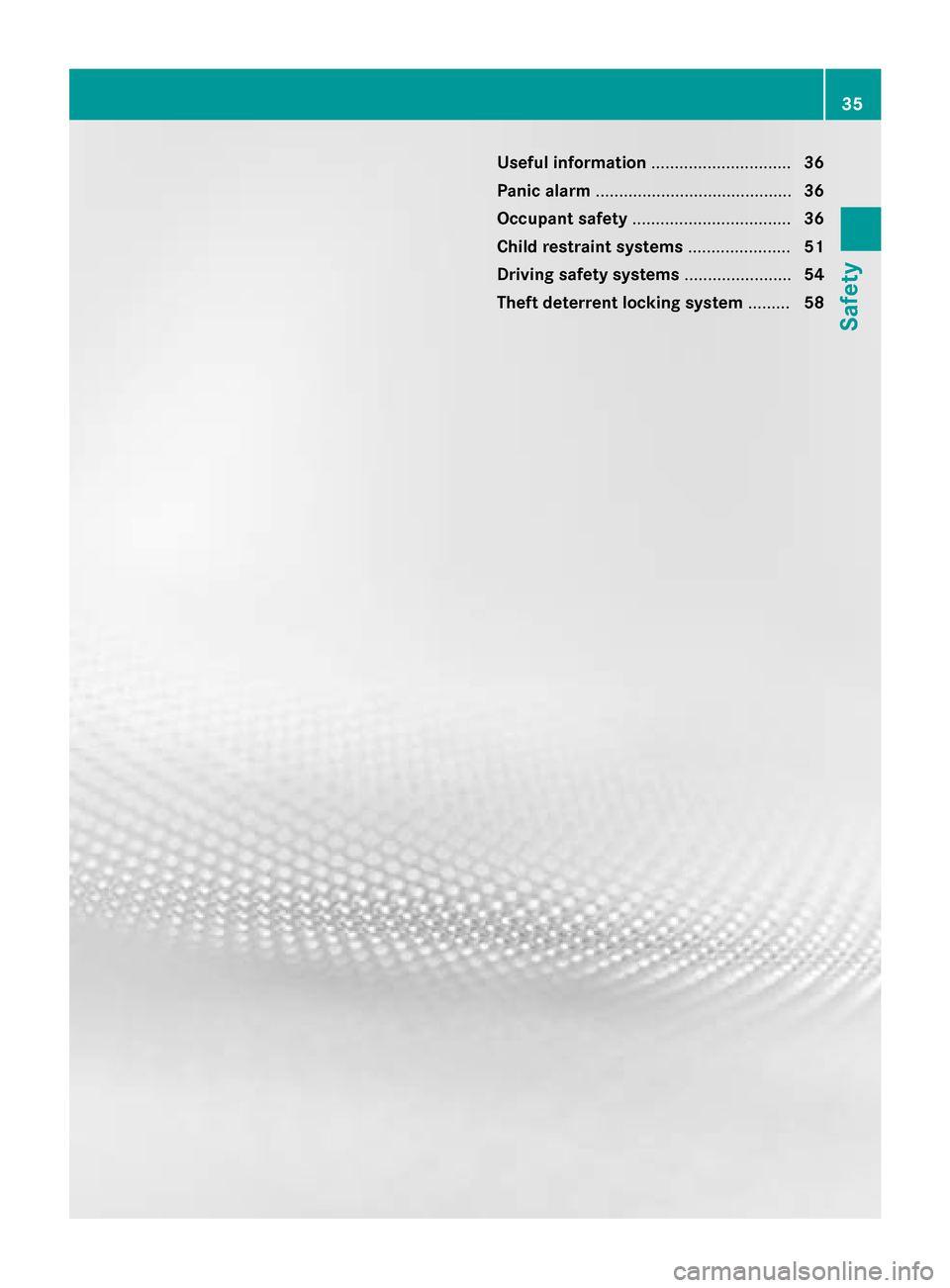
Useful information
..............................36
Panic alarm .......................................... 36
Occupant safety .................................. 36
Child restraint systems ......................51
Driving safet ysystems ....................... 54
Thef tdeterrent locking system .........58 35Safety
Page 38 of 290
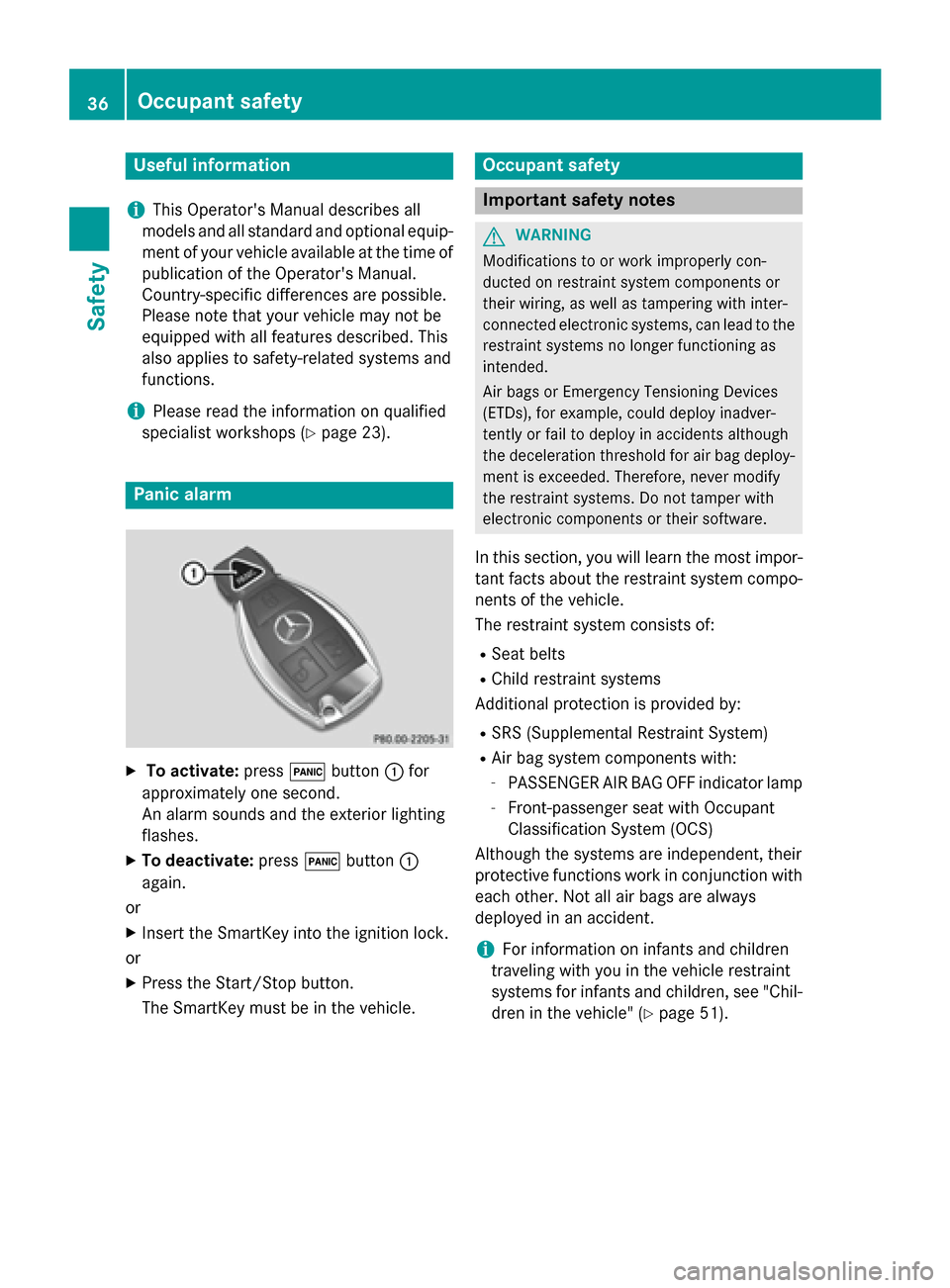
Useful information
i This Operator's Manual describes all
models and all standard and optional equip- ment of your vehicle available at the time of
publication of the Operator's Manual.
Country-specific differences are possible.
Please not ethat your vehicle may not be
equipped with all feature sdescribed. This
also applies to safety-related system sand
functions.
i Please read the information on qualified
specialist workshops (Y page 23).Panic alarm
X
To activate: press0033button 0043for
approximately one second.
An alarm sounds and the exterior lighting
flashes.
X To deactivate: press0033button 0043
again.
or
X Insert the SmartKey int othe ignition lock.
or X Press the Start/Stop button.
The SmartKey must be in the vehicle. Occupant safety
Important safet
ynotes G
WARNING
Modifications to or work improperly con-
ducted on restraint system components or
their wiring, as well as tampering with inter-
connected electronic systems, can lead to the restraint system snolonger functioning as
intended.
Air bags or Emergenc yTensioning Devices
(ETDs), for example, could deploy inadver-
tently or fail to deploy in accidents although
the deceleration threshold for air bag deploy- ment is exceeded. Therefore, neve rmodify
the restraint systems. Do not tamper with
electronic components or their software.
In this section, you will learn the most impor-
tan tfact sabout the restraint system compo-
nents of the vehicle.
The restraint system consists of:
R Seat belts
R Child restraint systems
Additional protection is provided by:
R SRS (Supplemental Restrain tSystem)
R Air bag system components with:
- PASSENGER AIR BAGO FF indicator lamp
- Front-passenger seat with Occupant
Classification System (OCS)
Although the system sare independent ,their
protective function swork in conjunction with
each other .Not all air bags are always
deployed in an accident.
i For information on infants and children
traveling with you in the vehicle restraint
system sfor infants and children ,see "Chil-
dren in the vehicle" (Y page 51).36
Occupant safetySafety
Page 41 of 290
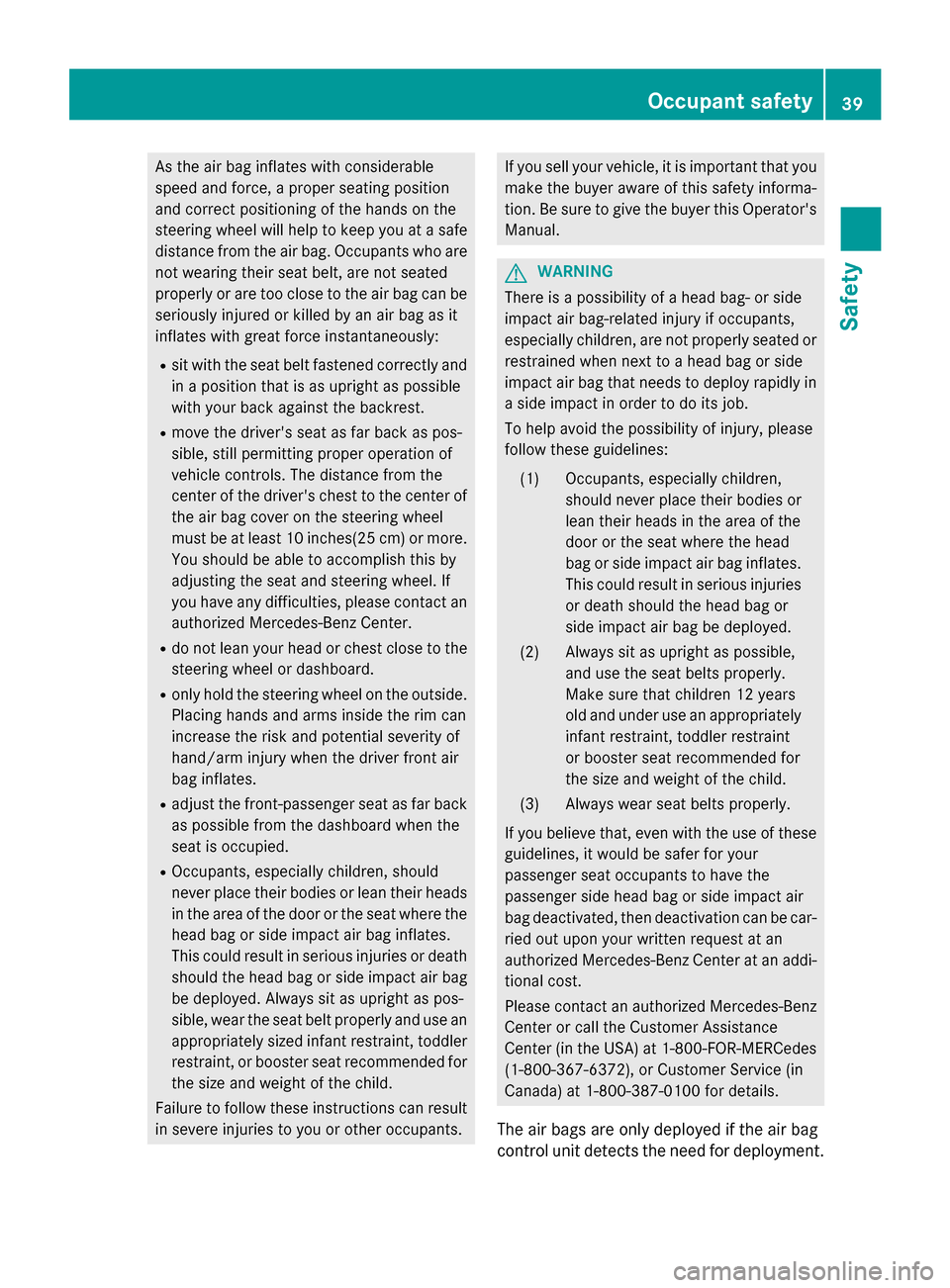
As the ai
rbag inflate swithc onsiderable
speed and force, aprope rseating position
and correct positioning of the hands on the
steering whee lwillh elptok eepy ou atas afe
distance from the ai rbag.O ccupants wh oare
not wearing thei rseatb elt, ar enot seated
properly or ar etoo close to the ai rbag can be
seriously injured or kille dbyanairba gasit
inflate swithg reat forc einstantaneously:
R sitw itht he sea tbeltf astene dcorrectl yand
in ap osit iont hatisasu pright as possible
with your back against the backrest.
R move the driver's sea tasfar back as pos-
sible, still permitting prope roperatio nof
vehicl econtrols .The distance from the
cente rofthe driver's chest to the cente rof
the ai rbag cove ront he steering wheel
must be at leas t10inches(25 cm) or more.
Yo us houl dbea bletoa ccomplis hthisby
adjusting the sea tand steering wheel. If
yo uh avea ny difficulties, please contact an
authorize dMercedes-Benz Center.
R do not lean your hea dorchest close to the
steering whee lordashboard.
R onl yholdt he steering whee lonthe outside.
Placing hands and arms insid ethe rim can
increase the ris kand potential severity of
hand/arm injury when the driver front air
ba ginflates.
R adjus tthe front-passenger sea tasfar back
as possibl efrom the dashboard when the
sea tiso ccupied.
R Occupants, especially children, should
neve rplace thei rbodies or lean thei rheads
in the area of the door or the sea twhere the
hea dbagor side impact ai rbag inflates.
Thi scould resul tinserious injurie sordeath
shoul dthe hea dbagor side impact ai rbag
be deployed .Alway ssitas upright as pos-
sible, wear the sea tbeltp roperly and us ean
appropriately sized infant restraint, toddler
restraint, or booste rsea trecommende dfor
the size and weight of the child.
Failure to follo wthes einstructions can result
in severe injurie stoyouor othe roccupants. If yo
uselly ou rvehicle, it is important tha tyou
make the buye raware of thissafety informa-
tion. Be sure to give the buye rthisO perator's
Manual. G
WARNING
There is apossibility of aheadb ag-ors ide
impact ai rbag-related injury if occupants,
especially children, ar enot properly seated or
restrained when next to aheadb agor side
impact ai rbag tha tneeds to deploy rapidl yin
as idei mpact in order to do its job.
To hel pavoid the possibility of injury ,please
follo wthes eguideli nes:
(1) Occupants, especially children, shouldneve rplace thei rbodies or
lean thei rheads in the area of the
door or the sea twhere the head
ba gors idei mpact ai rbag inflates.
Thi scould resul tinserious injuries
or death shoul dthe hea dbagor
side impact ai rbag be deployed.
(2) Alway ssitas upright as possible,
and us ethe sea tbelts properly.
Make sure tha tchildren 12 years
ol da nd under us eanappropriately
infant restraint, toddle rrestraint
or booste rseatrecommende dfor
the size and weight of the child.
(3) Alway swears eatb elts properly.
If yo ubeliev ethat, eve nwitht he us eofthese
guidelines, it woul dbesafer for your
passenge rseato ccupants to have the
passenge rsideh eadb agor side impact air
ba gd eactivated ,then deactivatio ncan be car-
rie do utupon your written request at an
authorize dMercedes-Benz Center at an addi-
tional cost.
Please contact an authorize dMercedes-Benz
Center or cal lthe Customer Assistance
Center (i nthe USA) at 1-800-FOR-MERCedes
(1-800-367-6372) ,orCustomer Service (in
Canada) at 1-800-387-010 0for details.
The ai rbagsa reonl ydeploye difthe ai rbag
contro lunitd etects the nee dfor deployment. Occupant safety
39Safety Z
Page 45 of 290
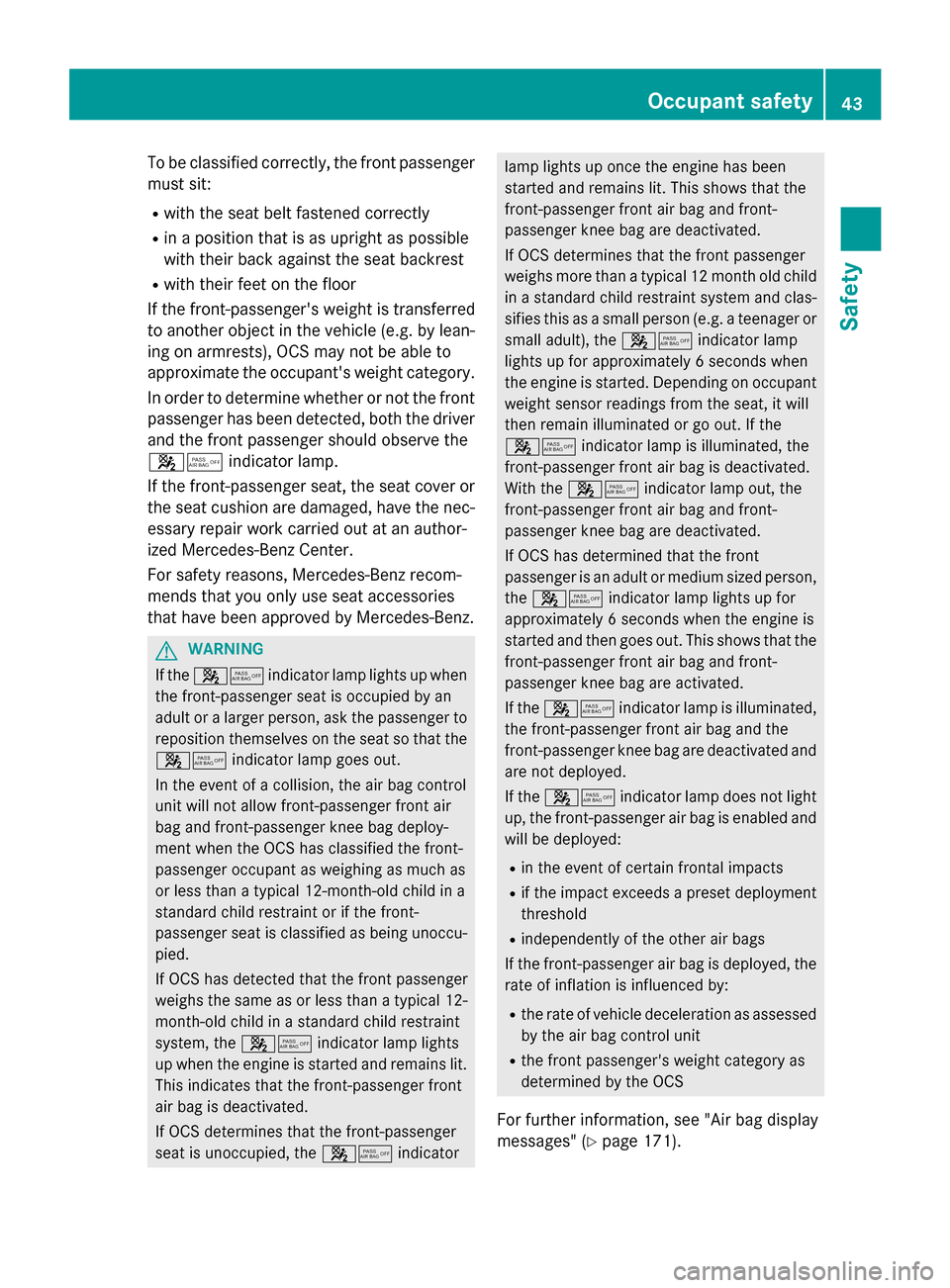
To be classified correctly, the frontp
assenger
must sit:
R with the seat belt fastened correctly
R in ap osition that is as upright as possible
with their back against the seat backrest
R with their feet on the floor
If the front-passenger's weight is transferred
to another object in the vehicle (e.g. by lean-
ing on armrests), OCS may not be able to
approximate the occupant's weight category.
In order to determin ewhether or not the front
passenger has been detected, both the driver and the frontp assenger should observe the
00730074 indicator lamp.
If the front-passenger seat, the seat cover or the seat cushion are damaged, have the nec- essary repair work carried out at an author-
ized Mercedes-Benz Center.
For safety reasons, Mercedes-Benz recom-
mends that you only use seat accessories
that have been approved by Mercedes-Benz. G
WARNING
If the 00730074 indicator lamp lights up when
the front-passenger seat is occupied by an
adult or alarger person, ask the passenger to
reposition themselves on the seat so that the
00730074 indicator lamp goes out.
In the event of acollision, the air bag control
unit will not allow front-passenger fronta ir
bag and front-passenger knee bag deploy-
ment when the OCS has classified the front-
passenger occupant as weighing as much as
or less than atypical 12-month-old child in a
standard child restraint or if the front-
passenger seat is classified as being unoccu-
pied.
If OCS has detected that the frontp assenger
weighs the same as or less than atypical 12-
month-old child in astandard child restraint
system, the 00730074indicator lamp lights
up when the engine is started and remains lit. This indicates that the front-passenger front
air bag is deactivated.
If OCS determines that the front-passenger
seat is unoccupied, the 00730074indicator lamp lights up once the engine has been
started and remains lit. This shows that the
front-passenger fronta
ir bag and front-
passenger knee bag are deactivated.
If OCS determines that the frontp assenger
weighs more than atypical 12 montho ld child
in as tandard child restraint system and clas-
sifies this as asmall person (e.g. ateenager or
small adult), the 00730074indicator lamp
lights up for approximately 6seconds when
the engine is started. Dependin gonoccupant
weight sensor readings from the seat, it will
then remain illuminated or go out. If the
00730074 indicator lamp is illuminated, the
front-passenger fronta ir bag is deactivated.
With the 00730074 indicator lamp out, the
front-passenger fronta ir bag and front-
passenger knee bag are deactivated.
If OCS has determined that the front
passenger is an adult or medium sized person, the 00730074 indicator lamp lights up for
approximately 6seconds when the engine is
started and then goes out. This shows that the
front-passenger fronta ir bag and front-
passenger knee bag are activated.
If the 00730074 indicator lamp is illuminated,
the front-passenger fronta ir bag and the
front-passenger knee bag are deactivated and
are not deployed.
If the 00730074 indicator lamp does not light
up, the front-passenger air bag is enabled and
will be deployed:
R in the event of certain frontal impacts
R if the impact exceeds apreset deployment
threshold
R independently of the other air bags
If the front-passenger air bag is deployed, the
rate of inflation is influenced by:
R the rate of vehicle deceleration as assessed
by the air bag control unit
R the frontp assenger's weight category as
determined by the OCS
For further information, see "Air bag display
messages" (Y page 171). Occupant safety
43Safety Z
Page 46 of 290
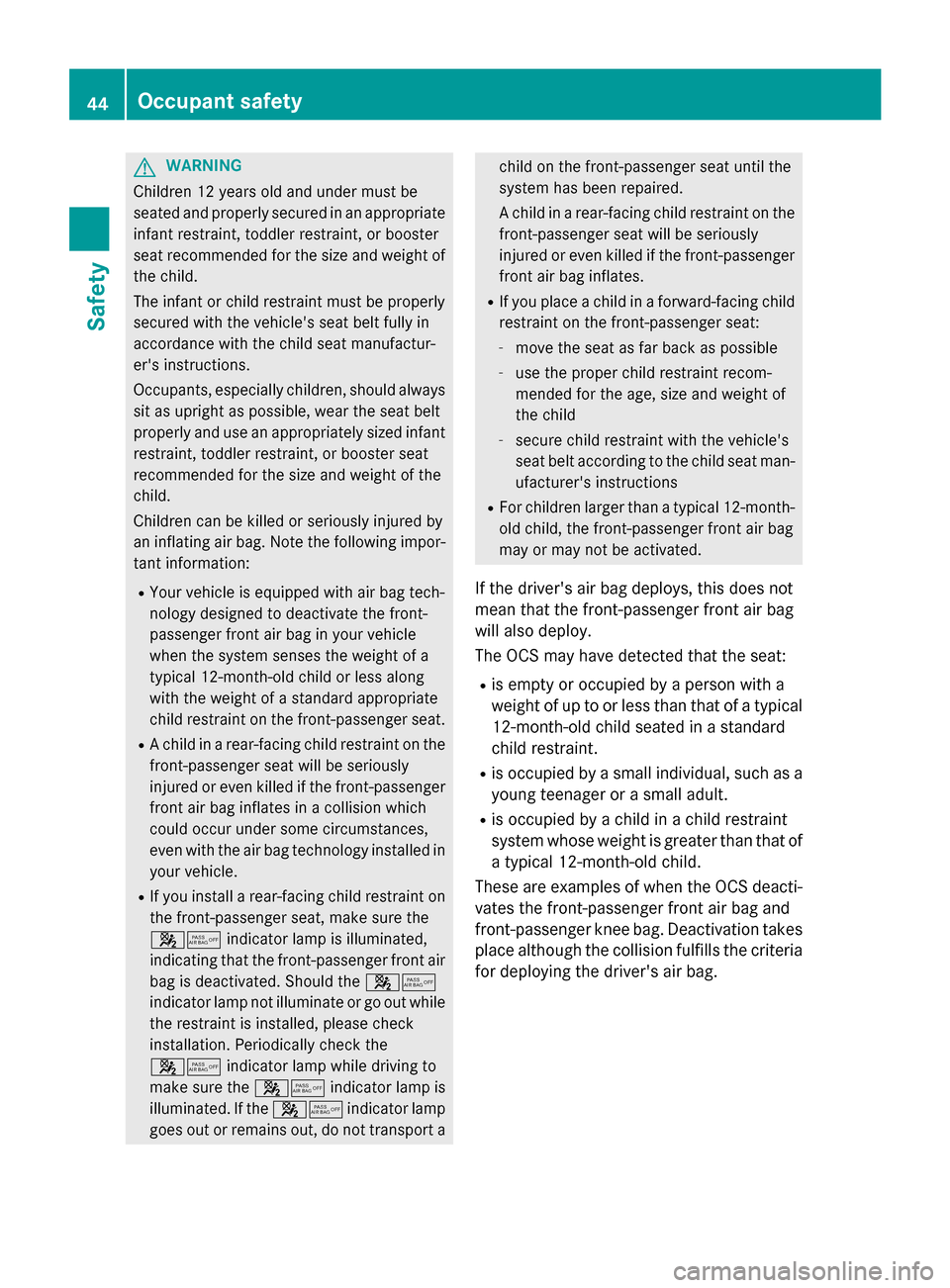
G
WARNING
Childre n12years old and under must be
seated and properly secure dinanappropriate
infant restraint, toddle rrestraint, or booster
seat recommende dfor the size and weight of
the child.
The infant or child restraint must be properly
secure dwith the vehicle's seat beltf ullyin
accordance with the child seat manufactur-
er's instructions.
Occupants, especially children, should always
sit as upright as possible,w earthe seat belt
properly and use an appropriately sized infant
restraint, toddler restraint, or booster seat
recommende dfor the size and weight of the
child.
Childre ncan be kille dorseriouslyi njured by
an inflating air bag.N ote the following impor-
tant information:
R Yourv ehicleise quipped with air bag tech-
nology designed to deactivate the front-
passenger front air bag in yourv ehicle
when the system senses the weight of a
typical 12-month-old child or less along
with the weight of astandard appropriate
child restraint on the front-passenge rseat.
R Ac hild in arear-facing child restraint on the
front-passenge rseat willbes eriously
injured or even kille difthe front-passenger
front air bag inflates in acollision which
coul doccur under some circumstances,
even with the air bag technology installed in yourv ehicle.
R If you install arear-facing child restraint on
the front-passenge rseat, make sure the
00730074 indicator lamp is illuminated,
indicating that the front-passenge rfront air
bag is deactivated. Shoul dthe 00730074
indicator lamp not illuminate or go out while the restraint is installed, please check
installation. Periodically check the
00730074 indicator lamp while driving to
make sure the 00730074indicator lamp is
illuminated. If the 00730074indicator lamp
goes out or remains out, do not transport a child on the front-passenge
rseat until the
system has been repaired.
Ac hild in arear-facing child restraint on the
front-passenge rseat willbes eriously
injured or even kille difthe front-passenger
front air bag inflates.
R If you place achild in aforward-facing child
restraint on the front-passenge rseat:
- move the seat as far back as possible
- use the prope rchild restraint recom-
mended for the age,s ize and weight of
the child
- secure child restraint with the vehicle's
seat belta ccording to the child seat man-
ufacturer's instructions
R For children larger than atypical 12-month-
old child ,the front-passenge rfront air bag
may or may not be activated.
If the driver's air bag deploys,t his does not
mean that the front-passenge rfront air bag
willa lsod eploy.
The OCS may have detected that the seat:
R is empty or occupied by aperso nwith a
weight of up to or less than that of atypical
12-month-old child seated in astandard
child restraint.
R is occupied by asmal lindividual, such as a
young teenage rorasmalladult.
R is occupied by achild in achild restraint
system whos eweight is greater than that of
at ypical 12-month-old child.
These are examples of when the OCS deacti- vates the front-passenge rfront air bag and
front-passenge rknee bag.D eactivation takes
place although the collision fulfills the criteria for deploying the driver's air bag. 44
Occupant safetySafety
Page 47 of 290
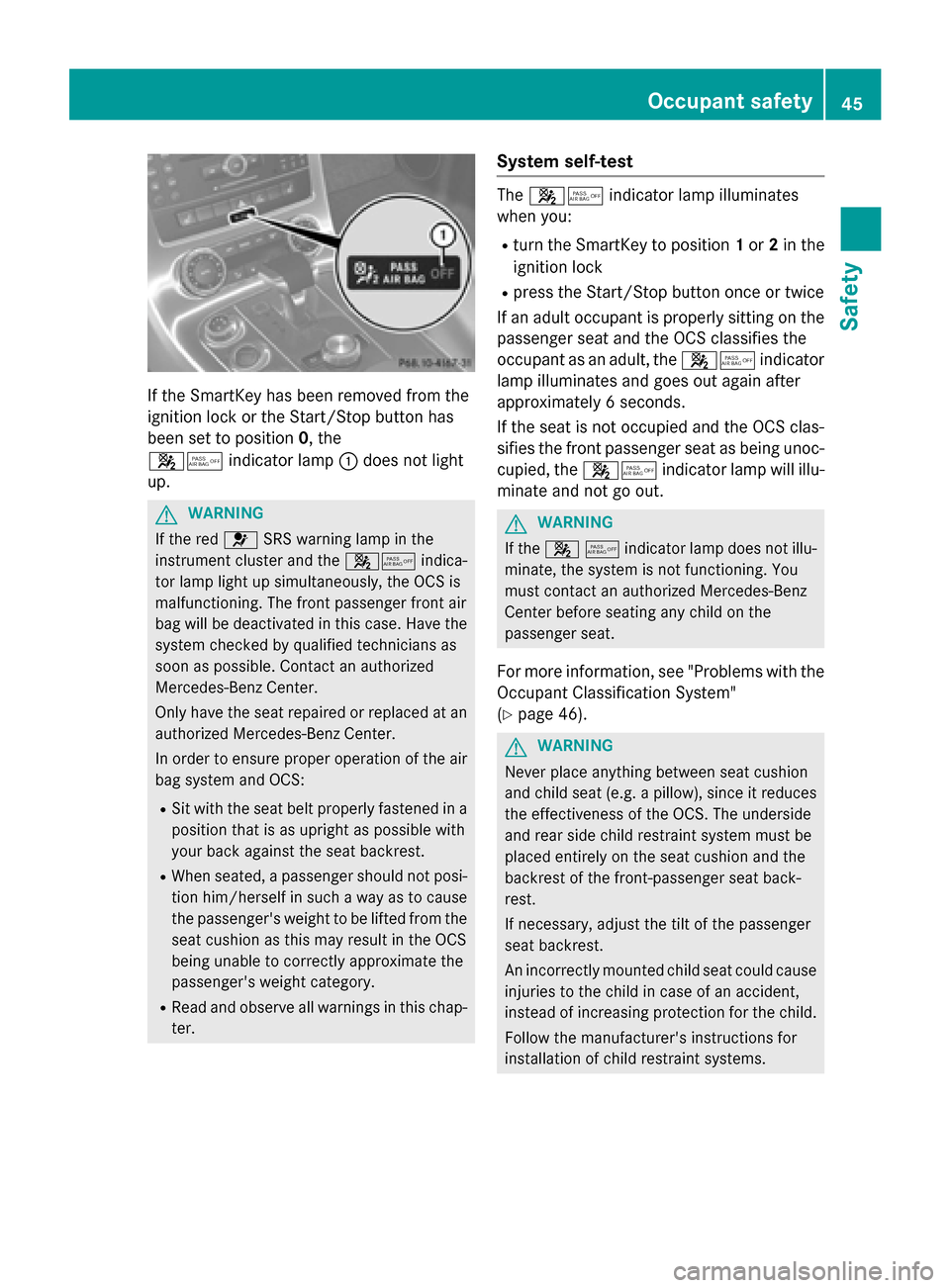
If the SmartKey has been removed from the
ignition lock or the Start/Stop button has
been set to position 0,the
00730074 indicator lamp 0043does not light
up. G
WARNING
If the red 0075SRS warning lamp in the
instrument cluster and the 00730074indica-
tor lamp lightu psimultaneously, the OCS is
malfunctioning. The front passenger front air
bag willbed eactivated in this case. Have the
system checked by qualifiedt echnicians as
soon as possible. Contact an authorized
Mercedes-Benz Center.
Only have the seat repaired or replaced at an
authorized Mercedes-Benz Center.
In order to ensure proper operation of the air
bag system and OCS:
R Sit with the seat belt properl yfastened in a
positio nthat is as upright as possible with
yourb ack against the seat backrest.
R When seated, apassenger shouldn ot posi-
tion him/hersel finsuchaway as to cause
the passenger's weight to be lifted from the seat cushio nasthis may resultint he OCS
being unabletoc orrectly approximate the
passenger's weight category.
R Reada nd observe all warnings in this chap-
ter. System self-test The
00730074 indicator lamp illuminates
when you:
R turn the SmartKey to position 1or 2in the
ignition lock
R press the Start/Stop button once or twice
If an adult occupant is properl ysitting on the
passenger seat and the OCS classifies the
occupant as an adult, the 00730074indicator
lamp illuminates and goes out again after
approximately 6seconds.
If the seat is not occupie dand the OCS clas-
sifies the front passenger seat as being unoc-
cupied, the 00730074indicator lamp willi llu-
minate and not go out. G
WARNING
If the 00730074indicator lamp does not illu-
minate, the system is not functioning. You
must contac tanauthorized Mercedes-Benz
Center befor eseatin gany child on the
passenger seat.
For more information, see "Problem swith the
Occupant Classification System"
(Y page 46). G
WARNING
Never place anything betwee nseat cushion
and child seat (e.g. apillow), sinc eitreduces
the effectiveness of the OCS. The underside
and rear side child restraint system must be
placed entirely on the seat cushio nand the
backrest of the front-passenge rseat back-
rest.
If necessary, adjust the tilt of the passenger
seat backrest.
An incorrectly mounted child seat could cause
injuries to the child in case of an accident,
instead of increasin gprotection for the child.
Follow the manufacturer' sinstructions for
installation of child restraint systems. Occupant safety
45Safety Z